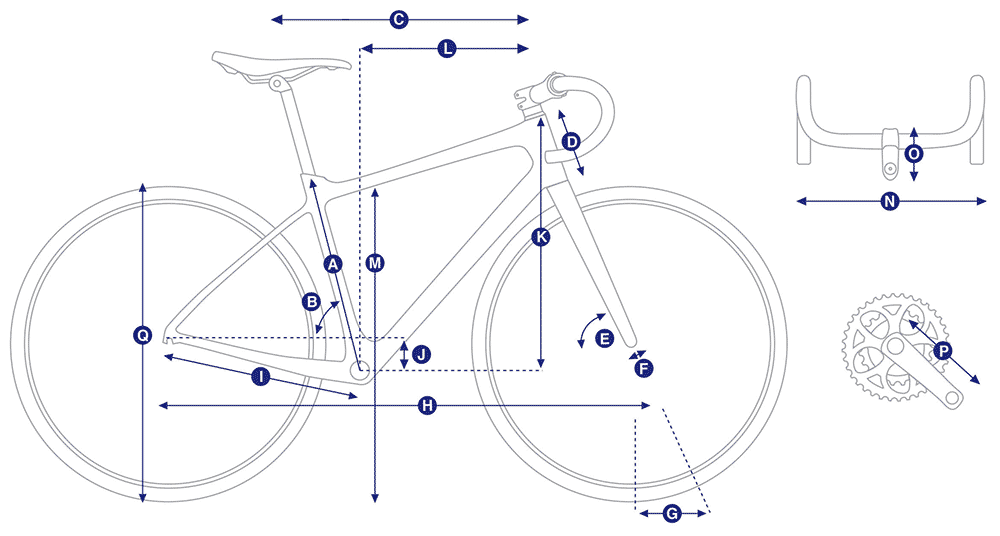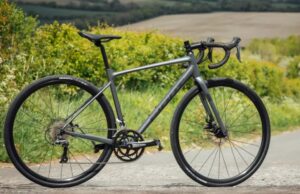Inexpensive and Versatile Giant Contend AR 4 – Review
The Giant Contend is a well-known bike model. Many people are familiar with the frame’s three available materials: carbon, aluminum, and disc or rim brakes. Such a unifying design for all ages and tastes.
The only stumbling block that kept many people from benefitting from the Contend AR’s benefits was the price. To bring the cost down by $2 below the psychological barrier of 1000 dollars, Giant made numerous concessions in order to create the new Giant Contend AR4. Let’s have a look at what it produced.
 Giant Contend AR 4
Giant Contend AR 4
Aluminum frame endurance bike
- Lightweight Aluminum Frame
- Inexpensive
- All-rounder appeal
- Easy maintenance
Hardware and Appearance
The “AR” in the name suggests that the bike was designed to be an all-rounder, meaning it can conquer any type of road. So why do we need gravel bikes then? Good question…
The line between highway and gravel bikes is becoming increasingly blurred to where they are almost indistinguishable from one another. For example, if you swapped out the handlebars on a highway bike with those typically found on a gravel bike (i.e. spread apart at the bottom), few people would know the difference.
It may be difficult to tell if a bike is meant for highways or gravel roads, but they are designed for different purposes. Gravel bikes are mostly built for dirt roads but can still travel on pavement whereas Contend AR4 is the reverse–it’s intended strictly for asphalt. There are other distinguishing factors between the two as well.

- Nice price tag
- Good running characteristics
- The wheels are 32 mm wide
- Disc brakes and 12 mm axles
- The wheels are ready for tubeless use
- Heavy frame and wheels
- Shimano Claris groupset has only 8 speeds
- D-shaped seatpost
- single-sided mechanical disc brakes
Frame
Because the AR4 frame is made from cheap aluminum with a single batting, it’s logical that demanding sources would be cheaper and production process wouldn’t require as much. As a result, there is no sanding of seams or full wiring integration present–though interesting in its own way.
The frame is not as rigid, but that’s okay because this bike is for beginner riders. They’re probably not going to be using it to race the Tour de France anytime soon. Most likely they’ll just use it to commute or take leisurely rides on the weekends… and a less rigid frame should be fine for that.
Fork
The fork is constructed of carbon, which is not a typical material for bikes in this price range. Of course, if we’re talking about a small regional brand that no one has ever heard of, there will be a $600 carbon fork.
We’re talking about a worldwide brand with competitors like Specialized, Cannondale, and others. Their pricing strategy is unique, as are their market presence nuances. Steel or aluminum aren’t used; instead, it’s all carbon. Furthermore, the stem of the fork is tapered to enhance stiffness.
Wheels
The Giant S-R2 Disc wheels are installed on the bike and they are tubeless with an inner rim width of 17.2 mm. The AR4 comes from the factory with 32mm wheels, but the 12mm axles make it possible to upgrade them in the future if you desire.
It’s worth noting that the frame is compatible with tires as wide as 40 mm. Once again, you may use tires up to 40 mm broad! Many gravel bicycles have wheels no wider than 42 mm. Yes, there is still a focus on having dirt clearance.
When I claim that the line between gravel and highway wheels has been blurred, I don’t just mean this point. It’s difficult to grasp precisely what I’m referring to. What should we say if cyclocrossers can’t afford such extravagance?
During the test cycles, some writers were able to mount 650B wheels with a 47mm tire width on the bike, and it felt good. Mud gaps, on the other hand, are a little narrow. However, because it’s a roadster, the outcome is remarkable.
Seatpost
The seatpost is a separate topic. It is made of aluminum with D-Fuse technology, which gives it a truncated profile that aids in aerodynamics and comfort. If it’s not clear, its profile resembles the letter D. Most likely, from a position of comfort, this design makes sense, but the issue here is that the frame can only be adapted for seatposts of this same profile.
A doubtful decision
The proprietary technology used gives the design a more pleasant look. Additionally, the seatpost clamp is designed to be hidden and it does its job well. When mentioning poles, it’s worth noting that both the handlebar and stem are made out of aluminum – which is standard – but nothing too notable.
Disc brakes
 Disc brakes are admired at first glance. Still, we’re talking about a bicycle for novices with a budget that appears to be very low. A more thorough look, on the other hand, elicits a completely different reaction. Yes, there are disc brakes on this bike, but they’re operated by a mechanical Tektro MD-C550 with 160 rotors and only one pad drive.
Disc brakes are admired at first glance. Still, we’re talking about a bicycle for novices with a budget that appears to be very low. A more thorough look, on the other hand, elicits a completely different reaction. Yes, there are disc brakes on this bike, but they’re operated by a mechanical Tektro MD-C550 with 160 rotors and only one pad drive.
The simplest and most cost-effective form, which is frequently inferior in performance to hydraulic brakes. The disc brake, on the other hand, remains and works. You may get optimal efficiency and power from such a system by following a good maintenance plan.
The carriage
The carriage is finished with a square carriage and… this is, without a doubt, the most disappointing aspect of the bike. However, this isn’t an issue for the novice highwayman since his tolerance to such things will develop over time. It’s feasible to learn and comprehend what a “highway” is on such a projectile.
The main issue with quad carriages is that they’re oftentimes very heavy and not stiff enough for those who pedal hard. With that said, there are no other qualms about them.The Giant Contend AR4 uses a Shimano Claris groupset on 8 speeds with a cassette going from 11-34 teeth; FSA Tempo crank system contains two 50/34 sprockets–just like most similar products in this price range.
Geometry
The TCR Advanced has a 975 mm wheelbase, whereas the regular TCR has a 1000mm wheelbase. The steering stem angle is 72 degrees and the seat tube angle is 73.5 degrees in size M. The base length is 1010mm and the handlebar width is 42cm, which indicates that the fit is more relaxed than on company’s racing bikes.
The same steering stem on the TCR Advanced, a racing car, measures 73 degrees in the same size. As a result, the difference isn’t significant. And there’s really no difference between them – both have exactly 975 mm of wheelbase.


The new AR4 is more laid-back in comparison with the racing bikes from Giant. This, plainly, how it’s produced so that novices may try an aggressive posture without having to stretch their bodies into impossible postures while cycling. We’re also discussing an endurance bike here, where ride comfort takes precedence over distance capability for the sake of covering a large number of kilometers at once.
Unlike road racing bikes, this bike is perfect for a leisurely commute to work or running errands. The 40 mm tires contribute to a comfortable ride.
The size grid is designed to include sizes XS, S, M, ML, L and XL. What’s clever is that the frame geometry changes depending on the chosen size. This might seem like common sense now but manufacturers only recently started using this approach which was once considered innovative. For example: The angle of the steering tube in an XS sized bike is 71.5 degrees while in an XL it’s 72.5 degrees- a one degree difference can make all the difference between an endurance bike or a racing bike!
Upgrade possibilities
It’s hard to know why the company ambushed future bike owners with a D-shaped seatpost, but it will be difficult to find an exact replacement on the market. In other words, you’ll likely only be able to find a new carbon seatpost from Giant, and pumping your bike could become problematic.
In my opinion, it is best to have a braking system that can be pumped. This gives hydraulics more power and disc brakes are much better than traditional rim brakes. While this might be costly, it will save you money in the long run as you won’t have to replace your brake pads as often.

It’s also worth considering parallel drive calipers. Mechanical, but the braking performance on such a system is considerably superior. It’s easier to install them and the pads will wear evenly; the stop on the handle will be strong, almost like hydraulic. There won’t be any hydraulic efficiency, it’s true, but why not have some fun?
It’s not worth it to upgrade from a big fork to a lighter one. For not much money, you’ll almost certainly find something better. And, for example, installing expensive wheels weighing 1.3 kg on a bike with a value that will be even less than these very wheels might well be considered an irresponsible act. The system of connecting rods linking the carriage unit to the rear axle is immediately questionable. Weight and stiffness are two factors that must be taken into account here.
You probably won’t notice the difference if you’re a beginner, but it will affect how the bike feels. Also, the cost of even the simplest connecting rods for HollowTech II carriage is not bad at all.
The Claris groupset is easily apparent. While the quality of the bike’s components cannot be denied, we have already seen a lot better options in previous years. The obvious disadvantage of this group is the choice of bike and gears.While you can’t find anything better for this money, you’ll have to be content with 8 speeds. For city and weekend rides, a cassette should sufficient. It’s not worth considering upgrading your gearset when you still have a hefty frame with no outstanding stiffness elements to speak of.
Of course, installing a carbon steering wheel can provide additional comfort. However, when we evaluate all of the costs for the upgrade, we see that the price of the bike has risen dramatically and that perhaps a higher model had been preferable. That’s a case of personal taste. In many ways, upgrading your bike is really gratifying. It’s in this format that you may discover things about materials’ stiffness and quality as well as different levels of equipment… a lot of information you could learn in this manner
Available options
 We cannot talk about the Contend without mentioning the AR prefix. The price tag, of course, starts at 775 dollars, but the absence of 12 mm axles and disk brakes makes it seem outdated.
We cannot talk about the Contend without mentioning the AR prefix. The price tag, of course, starts at 775 dollars, but the absence of 12 mm axles and disk brakes makes it seem outdated.
The AR range is represented by three models, where for some reason model AR2 has been omitted . At least the official website does not give any information on this model.
All bikes in this line share the same frame , but come in different colors- which are not very many to choose from .
The bike is equipped with a Shimano Claris groupset for 8 speeds, an aluminum D-saddle, 34/50 FSA Tempo connecting rods, and Giant S-R3 AC 700×32 tires with puncture protection. The wheels are mounted on Giant S-R2 Disc under 12mm axles. Tektro MD-C550 brakes with 160mm rotors are also included.
The crankset is the same as the previous model AR4, which uses a 9-speed Shimano Sora. The carriage has been updated to HollowTech II. All of the other components were taken from the AR4 youth model. That is, the primary difference between them is the groupset. Whether +1 speed is worth $250 is debatable. You may really decorate your bike with this much money.
The materials are comparable, but the version 2 looks entirely different. While keeping your eyes shut, this appears to be a different bike. The seatpost is still a D-pin, but it’s made of carbon fiber. Giant D-Fuse SL handlebars, Shimano FC-RS510 crank system, Giant P-R2 Disc wheels with 12mm axles and Giant Gavia Fondo 2 700X32c tubeless tires are all features of the model. An 11-speed Shimano 105 drivetrain with hydraulic disc brakes is the model’s most prominent feature.
